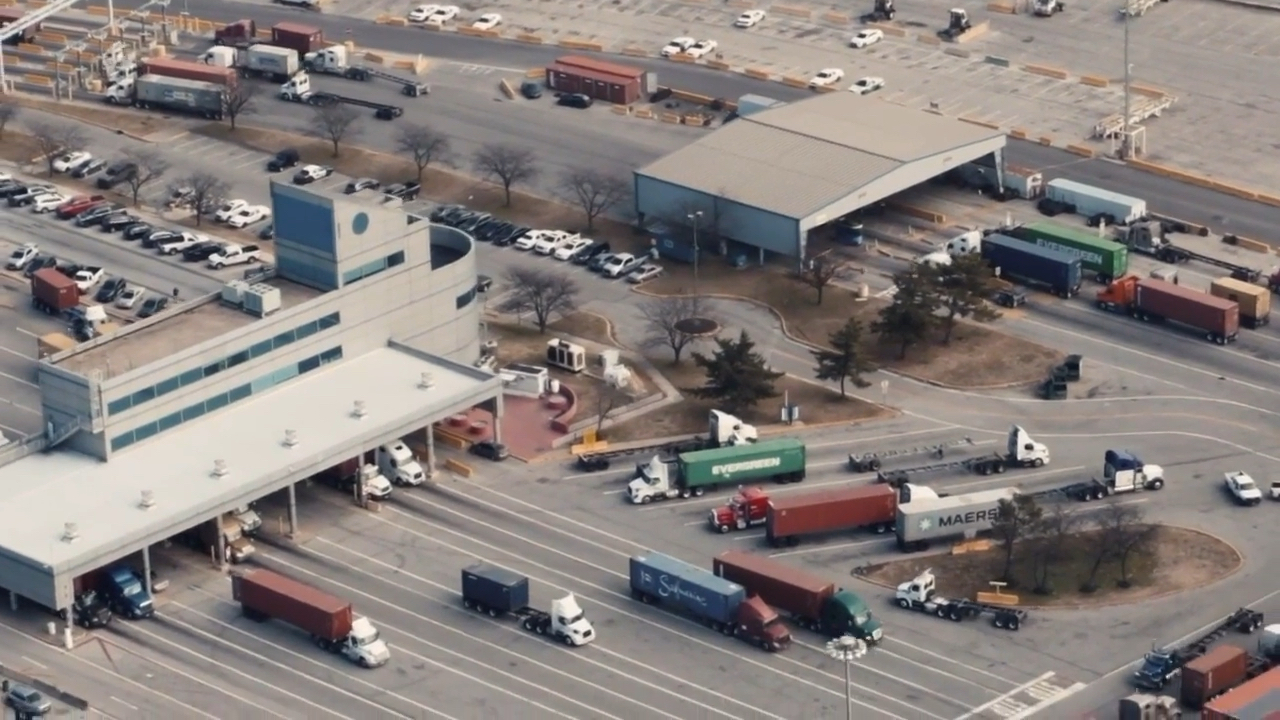Phone:
(678) 951-0626
Physical address:
4575 Webb Bridge Rd.
Suite #4345
Alpharetta, Georgia 30023

One of the key advantages of Logistics Gate Automation is the significant reduction in labor costs. By automating various processes such as entry and exit of vehicles, document verification, and ticketing, businesses can eliminate the need for excessive manual labor that would otherwise be required to manage these tasks. This not only leads to cost savings but also increases efficiency by minimizing human errors.
Logistics Gate Automation allows for faster and more streamlined operations, resulting in increased efficiency and throughput. By utilizing technologies such as RFID tags, barcode scanners, and license plate recognition systems, the entire Logistics process can be expedited. This leads to shorter waiting times, reduced congestion, and improved customer satisfaction.

Automation ensures greater accuracy in data collection and processing. By eliminating manual data entry, the chances of errors are significantly reduced. This enables businesses to have more reliable information for inventory management, supply chain optimization, and overall decision-making processes.
Logistics Gate Automation provides enhanced security and safety measures for both the facility and its personnel. Automated access control systems, such as biometric scanners, video surveillance, and alarm systems, can help prevent unauthorized entry and safeguard valuable assets. Additionally, automation reduces the need for physical interaction between personnel and visitors, minimizing the risk of potential threats or accidents.
Automation plays a crucial role in optimizing inventory management. By tracking and recording the movement of goods and materials in real time, businesses can have a clear picture of their inventory levels at any given moment. This helps in preventing stockouts, minimizing overstocking, and improving overall supply chain efficiency.
Logistics Gate Automation minimizes errors and losses by implementing stringent control measures. Automated systems ensure proper documentation, accurate record-keeping, and adherence to standard operating procedures. This reduces the chances of theft, misplacement, or damage to goods, ultimately resulting in cost savings for businesses.
Several factors can influence the cost reduction achieved through Logistics Gate Automation. Understanding these factors is crucial for businesses to make informed decisions regarding the implementation of automation solutions. Some of the key factors include:
The initial investment required for implementing Logistics Gate Automation can vary depending on the size and complexity of the project. Factors such as the number of entry and exit points, the level of integration with existing systems, and the choice of hardware and software solutions can all influence the implementation costs. However, it’s important to consider the long-term benefits and return on investment that automation solutions can provide.
While automation systems are designed for durability and longevity, maintenance and repair costs should be taken into account. Regular inspections, software updates, and occasional repairs may be necessary to ensure the system’s smooth functioning. By partnering with a reputable automation solution provider like TEKWave Solutions, businesses can minimize these costs through proactive maintenance strategies and excellent customer support.
Training plays a vital role in the successful implementation of Logistics Gate Automation. Businesses need to invest in training programs to educate their personnel on the proper usage and maintenance of the automated systems. Additionally, operational costs can include expenses related to energy consumption, system monitoring, and ongoing support. However, these costs are outweighed by the long-term benefits and cost reductions achieved through automation.
The extent of integration between the automation system and existing systems can impact the overall cost reduction. Well-integrated solutions enable seamless data sharing and compatibility with other software platforms, reducing the need for additional manual processes or data entry. Choosing an automation solution provider with expertise in system integration, such as TEKWave Solutions, ensures a smooth and cost-effective transition.
Businesses should consider the scalability and flexibility of the chosen automation solution. As operational needs change or expand, the automation system should be able to adapt and accommodate future requirements without significant additional costs. Choosing a solution that can scale with the business’s growth ensures long-term cost savings and maximizes the return on investment.
Ultimately, the return on investment is a crucial factor to consider when evaluating the cost reduction achieved through Logistics Gate Automation. While the upfront costs may seem significant, businesses should assess the long-term financial benefits and cost savings that automation can provide. These savings can be achieved through reduced labor costs, improved efficiency, minimized errors and losses, and optimized inventory management.

To showcase the impact of Logistics Gate Automation on cost reduction, let’s explore a few real-world examples:
A distribution center implemented Logistics Gate Automation, including RFID technology and automated barcode scanners. This enabled the center to have real-time visibility and accurate tracking of inventory, eliminating manual data entry and reducing errors. As a result, the distribution center experienced a significant reduction in labor costs, improved inventory accuracy, and enhanced overall operational efficiency.
 Cost Reduction in Distribution Centers
Cost Reduction in Distribution CentersBy automating processes such as vehicle identification, driver verification, and load inspections, distribution centers can achieve substantial cost savings. With the implementation of automation solutions, distribution centers can reduce the number of personnel required for manual inspections and streamline operations. This not only leads to faster throughput but also minimizes errors and losses, resulting in significant cost reductions.
Logistics Gate Automation plays a crucial role in optimizing supply chain management. Automated systems enable seamless tracking and tracing of goods from the point of entry to the final destination. By improving supply chain visibility and reducing lead times, businesses can minimize inventory carrying costs, avoid stockouts, and enhance overall supply chain efficiency.
Residential gated communities can leverage gate automation to enhance security and streamline operations. Automated access control systems, license plate recognition, and visitor management solutions can improve the efficiency of entry and exit processes. By reducing the need for manned gatehouses and manual record-keeping, residents and homeowners associations can achieve cost savings while ensuring a safe and secure environment.
Numerous businesses have experienced significant cost reductions and operational improvements through Logistics Gate Automation. Countless success stories and testimonials highlight the tangible benefits brought about by automation solutions. By partnering with TEKWave Solutions, businesses have achieved remarkable results, including substantial labor cost savings, increased efficiency, improved accuracy, and enhanced security measures.
To maximize the benefits and cost reduction achieved through Logistics Gate Automation, businesses should follow these best practices:
Selecting the right automation solution provider is crucial for a successful implementation. Look for providers with experience in the industry, a proven track record, and a reputation for delivering reliable and innovative solutions. TEKWave Solutions, with its years of expertise and customer-centric approach, stands out as a trusted partner in Logistics Gate Automation.
Ensure that the chosen automation solution can be tailored to meet the specific needs of your business. Customization allows for seamless integration with existing systems and ensures compatibility with other software platforms. By achieving optimal system integration, businesses can eliminate redundant processes, reduce manual input, and achieve greater cost savings.
Investing in regular maintenance and upgrades is essential for the longevity and optimal functioning of the automation system. Schedule regular inspections, perform software updates, and address any issues promptly to prevent potential disruptions. By following a proactive maintenance approach, businesses can minimize repair costs and ensure the system operates at its full potential.
Provide ongoing training and support to personnel involved in operating and maintaining the automation system. This ensures that employees are well-equipped to utilize the system effectively and resolve any minor issues that may arise. By fostering a culture of continuous learning and support, businesses can maximize the benefits of automation and achieve greater cost reduction.
Implement a robust monitoring system to track the performance of the automation system. Collect data, analyze key metrics, and identify areas for improvement or optimization. By regularly evaluating the system’s performance and addressing any bottlenecks or inefficiencies, businesses can further enhance cost reduction and operational efficiency.
The field of Logistics Gate Automation is constantly evolving. Several trends and innovations are shaping the future of this industry, promising even greater cost reduction and operational efficiency. Some of these trends include:
AI technology is revolutionizing Logistics Gate Automation by enabling systems to make intelligent decisions based on real-time data. AI algorithms can optimize routing, improve demand forecasting, and identify potential bottlenecks before they occur. By harnessing the power of AI, businesses can achieve even greater efficiency and cost savings in their Logistics operations.
The integration of IoT devices in Logistics Gate Automation allows for seamless communication and data exchange between various components. IoT sensors can provide real-time information about vehicle movements, environmental conditions, and equipment performance. This data enables businesses to make informed decisions, optimize processes, and minimize costs.
The use of autonomous vehicles and robotics in Logistics Gate Automation is gaining traction. Automated guided vehicles (AGVs) and drones can streamline material handling and transportation, reducing the need for manual labor. By implementing these technologies, businesses can achieve greater efficiency, faster throughput, and significant labor cost savings.
Predictive analytics and machine learning algorithms help businesses optimize their Logistics Gate Automation systems. By analyzing historical data, these technologies can predict future demand, optimize inventory levels, and optimize routing and scheduling. This leads to better decision-making, reduced costs, and improved overall operational efficiency.
Leveraging cloud-based solutions in Logistics Gate Automation offers numerous advantages. Cloud platforms enable real-time data sharing, remote access, and seamless collaboration between different stakeholders. By utilizing cloud-based solutions, businesses can achieve scalability, flexibility, and cost savings, as they eliminate the need for extensive on-premises infrastructure.
Logistics Gate Automation plays a vital role in improving efficiency, reducing costs, and enhancing safety and security in various industries. Benefits such as reduced labor costs, increased efficiency and throughput, improved accuracy and data collection, enhanced security and safety, optimized inventory management, and minimized errors and losses make automation a strategic investment. By adopting best practices, partnering with a reliable automation solution provider like TEKWave Solutions, and staying abreast of future trends and innovations, businesses can unlock the full potential of Logistics Gate Automation and achieve substantial cost reduction. Contact TEKWave Solutions today to explore your Logistics Gate Automation needs and experience the Tekwave Advantage.